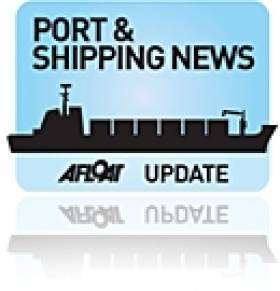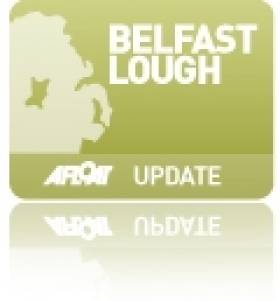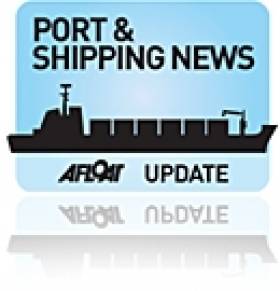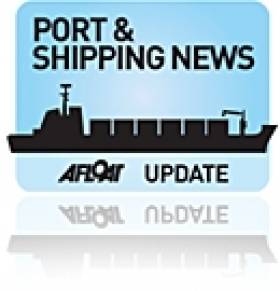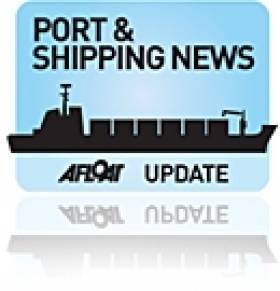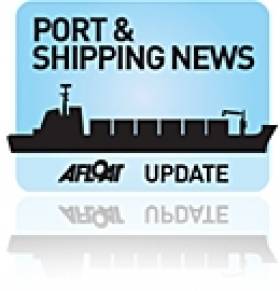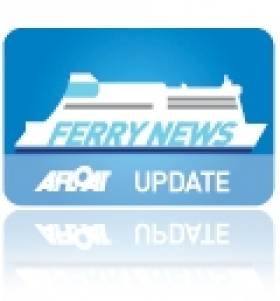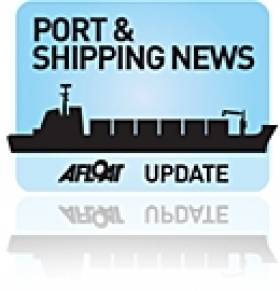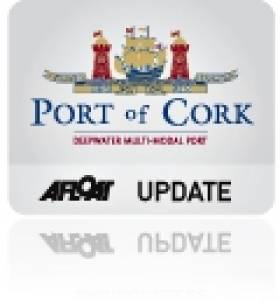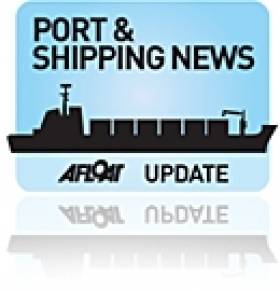Displaying items by tag: Ports and Shipping News
IMDO Weekly Review: EU/US Trade Deal Benefits, Container Flatlines, European Coal Slumps and more…
#Ports&Shipping –The latest IMDO Weekly Shipping Market Review includes the following stories as detailed below.
Irish Economy: EU/US trade deal - Ireland will benefit more than any other European country except Britain if the European Union and United States hammer out a new trade deal, a leading German think-tank believes. A deal that leads to "deep liberalisation" could boost average incomes here by almost 7% and create more than 18,000 jobs, the Ifo Institute said in a report published this week. The US would be the biggest beneficiary of any agreement with a 13.4% rise in income, according to Ifo, followed by Britain which would see 9.7% rise in incomes.
Container Market: Volumes flatline - Volumes from Asia to Europe grew just 0.1% in the first four months of the year to 4.4m TEU, according to the latest figures from Container Trades Statistics. This growth was mainly fuelled by an up-lift in Asia to Mediterranean services, with volumes declining from Asia to north Europe.
Dry Bulk Market: European coal demand - European demand for coal has slumped since the financial crisis, according to a special report from BIMCO. Ever since 2009, demand has deteriorated, falling by 14 million tonnes from the first to the second quarter. Import volumes during the last three quarters of 2011 indicated that seaborne coal demand was recovering, but the development stalled somewhat in 2012.
For more of the above visit the IMDO Weekly Markets Review (Week 24) and also on Afloat.ie's dedicated Ports & Shipping section
H&W Group Enjoy Successful Recovery
#BelfastLough – Belfast's Harland and Wolff Group (H&W) continues to operate as an expanding diverse engineering business.
The group has a number of special capabilities related to marine engineering and design, ship repair, and including offshore wind-farm fabrication. The company is a wholly owned subsidiary of the Norwegian Fred Olsen Energy Group.
In 2012, H&W enjoyed a significant increase in turnover and improved its profitability. This followed a loss in 2010 when trading conditions were described as 'externally challenging' and a recovery in 2011. For more on this story The Belfast Telegraph reports.
Purr... fect as Wind-Farm Cats Excel
#WindFarmCraft- Wicklow based marine-plant specialist Island Shipping look back on their pair of wind-farm support vessels (WFSV) introduced in recent years and with added satisfaction.
Following research of the 17m craft, they have performed particularly well with the best in the business but in order to verify it, the company took a closer look of their vessels log-books.
While operating for 20 months off the UK coast along the Sheringham Shoal Offshore Windfarm the Island Tiger and Island Panther carried out 37,205 logged personnel transfers.
At the peak of activity, in July 2012, the Island Panther carried out 2,152 logged personnel transfers during the month.
#NewESPOSecretary -At a meeting of the European Sea Ports Organisation (ESPO) held in the Romanian Black Sea port of Varna, the General Assembly of the organisation today appointed Isabelle Ryckbost as the new Secretary General.
Ms Ryckbost succeeds Patrick Verhoeven in this function who is taking on the position of Secretary General at the European Community Shipowners' Associations (ECSA) this summer.
Isabelle Ryckbost comes with an extensive background in EU policy-making and ports. She worked for more than fifteen years in the European Parliament, where she led the office of Dirk Sterckx, a Belgian MEP who was member of the Committee on Transport and Tourism.
During this period, she worked on a number of port-related files, including the two port service Directive proposals and the maritime safety packages. In 2009 Isabelle Ryckbost joined the port sector as Director of the European Federation of Inland Ports (EFIP), which operates from the ESPO offices in Brussels.
"I very much welcome Isabelle on board", said ESPO Chairman Santiago Garcia-Milà, "We are all confident she will do a great job. Apart from her professional and personal qualities, she is a true insider in Brussels and has an already operational network in our sector. This will ensure a very smooth transition."
"I feel honoured to be appointed as ESPO's new Secretary General. Replacing Patrick is quite a challenge I must say. But, with the support of the members and the assistance of a strong team at the secretariat, I hope to continue the good work of my predecessor".
She added "I look forward to representing Europe's seaports in Brussels. Ports are more than a business sector, they seek to combine economic and public interests. Being the main trade gates to Europe, they have a crucial role to play for our economy and welfare. But at the same time, ports are the driving force of many regions and have a responsibility towards their local community"
"I hope, where possible, to help oiling these engines of growth and, where needed, to protect them. I believe each port in Europe has its role and its place" concluded Ryckbost.
Ryckbost will take up her new function on 1 August. She will become the third Secretary General of ESPO. Prior to Patrick Verhoeven, who led the secretariat for the past thirteen years, the office was managed by the late Pamela Le Garrec.
IMDO Shipping Review: Modest Export Growth, Sub 3,000 TEU Challenges and Chinese Steel Bulk Boost
#Ports&Shipping –The latest IMDO Weekly Shipping Market Review includes the following stories as detailed below.
Irish Economy: Modest export growth - According to figures from the Central Statistics Office (CSO), seasonally-adjusted exports for March rose by 4 per cent from February. This signals the second consecutive month of modest increases, although foreign sales of goods made in Ireland remained subdued.
Fleet: Sub-3000teu challenges - The sub-3000 teu fleet faces looming headwinds due to the collapse of the German KG ship financing system, according to Drewy Maritime Research. These vessels, which are the workhorses of intra-regional services, tend to be environmentally damaging and fuel inefficient.
Dry Bulk Market: Chinese steel boost - Chinese steel production keeps growing, which could provide a boon to the dry bulk market, reported Lloyd's List last week. Despite warnings about a slowing China, April was the fourth consecutive month of draw-downs of iron ore stocks. "We believe capesize rates will stage a recovery in the second half of the year, on the back of seasonal higher exports from Brazil and restocking by Chinese steel mills," according to an analyst from RS Platou.
To read more of each of the above stories and other news from the IMDO Weekly Markets Review for Week 20, click HERE to view or download as a PDF
Detained Cargoship Shifts Berths for Cruise Caller
#DetainedCargoship – The detained Belize-flagged 19,000 tonnes cargo-bulker, Clipper Faith, previously reported on Afloat.ie, had to shift berths in Dublin port today so in order to accommodate a cruiseship, writes Jehan Ashmore.
In place of the Clipper Faith is the French flagged cruiseship Le Boreal, which is berthed near the East-Link toll-lift bridge along the North Wall Quay extension, the site of the proposed new dedicated cruise terminal which forms part of the Dublin Port masterplan.
Clipper Faith subsequently shifted berths downriver to the channel fairway and docked at the ESB jetty, where the bulker had originally berthed alongside more than two months ago.
#FarewellHSS- A fast-ferry that served the Belfast-Stranraer route, which no longer exists, departed Belfast for the final time at the weekend. The ferry HSS Stena Voyager is bound for Sweden where she is to be scrapped, writes Jehan Ashmore.
The 19,000 tonnes Stena Voyager is under tow to the Öresundsvarvet shipyard in Landskrona, where she will be recycled by a subsidiary of the ferry company, Stena Recycling.
All of the vessels various components will be recycled, as far as is possible, to maintain the company's environmental reputation. Some of the materials will even be reused in the form of car parts or furniture.
Stena Voyager was displaced on the Northern Channel route in November 2011 following the change of Scottish port, from Stranraer at the end of the lough to Cairnryan which is closer to the open sea.
In addition a pair of conventional yet fast ro-pax 'Superfast' ferries were introduced bringing superior facilities coupled with greater freight capacity.
These factors combined with a shorter passage time between Belfast and Cairnryan and rising fuel costs over several years saw the writing on the wall for the HSS craft, which when introduced in the mid 1990's were the pride of the Stena Line fleet.
The Swedish ferry giant commissioned a trio of HSS (High Speed sea-Service) fast-craft, whose futuristic appearance and technology was adopted from the world of aviation that included gas-turbine engines to power water-jets producing up to 40 knots.
Stena Voyager carried 1,500 passengers and 375 cars and she was launched onto the North Channel route in 1996, since then the fast-craft has carried more than 17m passengers and over 45,000 sailings.
"Whilst the HSS class was a unique and highly innovative development for Stena Line, unfortunately the spiralling costs of operating the Stena Voyager have become all too high. When the Voyager was first put into service fuel was approximately $20 per barrel and now the price is around $110 dollar, for a fuel hungry vessel this is simply untenable," said Michael McGrath, Stena Line's Chief Operating Officer.
The first of the revolutionary craft was HSS Stena Explorer which currently maintains the seasonal-only Dun Laoghaire-Holyhead having been also introduced in 1996. Final member of the class was HSS Stena Discovery which served Harwich-Hook van Holland from 1997, however she was the first to go and now serves operators out of Venezuela.
The concept of the HSS craft were also to compete with air-travel on the short hop between Northern Ireland and Scotland. In tandem the HSS ran alongside older conventional ferries, among them Stena Caledonia, which was sold last year to Indonesian operator ASDP and renamed Port Link.
Drogheda Port Handled 1m Tonnes in 2012
#DroghedaPort – Over 1m tonnes of cargo was handled in 2012 by the Drogheda Port Company.
According to the Co. Louth port, this level of cargo outperformed the Irish port sector in terms of year on year throughput growth.
Throughputs increased by 95% on last years volumes and it is the first time since 2007 that the port handled over one million tonnes of cargo.
The latest national volumes indicate that the volume of port and shipping traffic through the Republic of Ireland showed little growth in the third quarter of 2012 according to the figures released by the Irish Maritime Development Office (IMDO).
The latest analysis of national traffic data indicates that two of the five principal freight segments returned to growth in the third quarter, two declined and one remained unchanged.
Against this backdrop Drogheda Port's volume growth is particularly impressive. Export volumes performed well with minerals, construction bulks and agri-trades all increasing.
The company is continuing to provide a competitive operational base to its many customers and attract new business with increased flexibility and facilities.
Nationally the outlook for the sector in 2013 remains challenging as continued uncertainty in the European and wider Global Economy continues to weaken market demand and impact on consumer confidence.
Commenting on the ports performance CEO Mr Paul Fleming said "The company is pleased to report that trade volumes increased significantly in 2012 and we will continue to grow volumes in 2013 in specific market sectors. It is also noteworthy that the port is playing a central role in facilitating the national export lead recovery."
He also noted "The company continues to support the local tourist economy with the first ever cruise call (as previously reported on Afloat.ie of the Clipper Adventurer) in 2012. A number of new maritime tourism initiatives will be announced in 2013 to support and stimulate the local economy."
Port of Cork Signs Up to Energy Savings
#EnergyCORK- The Port of Cork Company have signed up as a partner of Sustainable Energy Authority of Ireland (SEAI) at a launch held recently by Energy Cork.
The partnership will see the port implementing an Energy Action Plan which will contribute to the national Public Sector energy efficiency improvement target which has been set for 2020. 'The National Energy Efficiency Action Plan 2009-2020' set a target of 33% reduction in energy use and its fulfilment will have a significant impact on the success of the Irish economy and on the creation of a more sustainable environment into the future.
This strategic plan will work in conjunction with the Port of Cork's existing environmental policy, and will aim to deliver energy savings of at least 3% annually which will see a significant reduction in energy consumption across the Port's operations.
Commenting on the partnership, Denis Healy, Manager of Engineering Services at the Port of Cork said "As we are a 24 hour port working 365 days a year, we are continuously looking for ways that we can become more energy efficient. This new partnership with the SEAI gives us a great opportunity to develop a structured programme and adopt best practice standards to work in a more sustainable way."
A key aim of the SEAI is to help public sector organisations achieve energy efficiency through facilitating the Partnership Programme, which offers a support package to large organisations towards meeting their obligations, in return for commitment to energy management.
The Port of Cork joins a number of other high profile organisations who have already become partners of the SEAI including UCC, the Defence Forces and Bus Eireann.
Cargoship to Dock in Fenit to Load Liebherr Cranes
#ShippingCRANES- Since Friday, the Stade, a 7,850 tonnes multi-lift cargo vessel has been at anchorage off Fenit Harbour, Co. Kerry, awaiting to berth, so to load container components from the Liebherr plant in Fossa, Killarney, writes Jehan Ashmore.
Due to weather conditions, the 146m long vessel which had sailed from Zeebrugge, is not expected to moor alongside Fenit Pier until tomorrow morning, weather permitting.
As previously reported on Afloat.ie, the international crane manufacturer's Irish based plant, has an order from the New Zealand south island port of Lyttelton, for four straddle-container carriers, due for delivery in mid-2013.
The export of container cranes are the port's only major commercial customer. Last August the port handled its largest ever vessel, the heavylift ship HHL Valparasio (2010/17,634grt) which departed with two ship-to-shore container cranes bound for the USA.




























